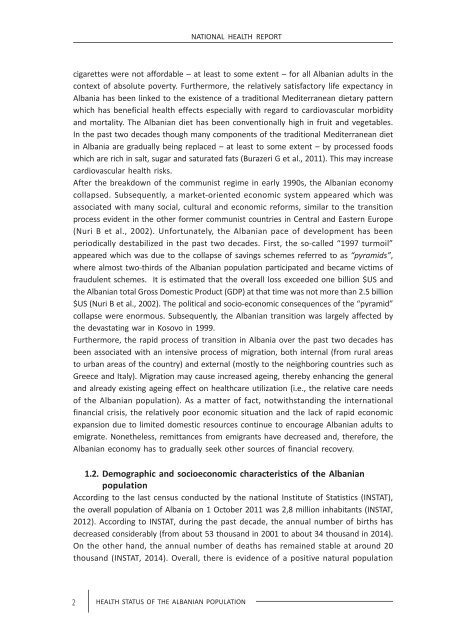Health-report-English-version
Health-report-English-version
Health-report-English-version
- No tags were found...
You also want an ePaper? Increase the reach of your titles
YUMPU automatically turns print PDFs into web optimized ePapers that Google loves.
NATIONAL HEALTH REPORTcigarettes were not affordable – at least to some extent – for all Albanian adults in thecontext of absolute poverty. Furthermore, the relatively satisfactory life expectancy inAlbania has been linked to the existence of a traditional Mediterranean dietary patternwhich has beneficial health effects especially with regard to cardiovascular morbidityand mortality. The Albanian diet has been conventionally high in fruit and vegetables.In the past two decades though many components of the traditional Mediterranean dietin Albania are gradually being replaced – at least to some extent – by processed foodswhich are rich in salt, sugar and saturated fats (Burazeri G et al., 2011). This may increasecardiovascular health risks.After the breakdown of the communist regime in early 1990s, the Albanian economycollapsed. Subsequently, a market-oriented economic system appeared which wasassociated with many social, cultural and economic reforms, similar to the transitionprocess evident in the other former communist countries in Central and Eastern Europe(Nuri B et al., 2002). Unfortunately, the Albanian pace of development has beenperiodically destabilized in the past two decades. First, the so-called “1997 turmoil”appeared which was due to the collapse of savings schemes referred to as “pyramids”,where almost two-thirds of the Albanian population participated and became victims offraudulent schemes. It is estimated that the overall loss exceeded one billion $US andthe Albanian total Gross Domestic Product (GDP) at that time was not more than 2.5 billion$US (Nuri B et al., 2002). The political and socio-economic consequences of the “pyramid”collapse were enormous. Subsequently, the Albanian transition was largely affected bythe devastating war in Kosovo in 1999.Furthermore, the rapid process of transition in Albania over the past two decades hasbeen associated with an intensive process of migration, both internal (from rural areasto urban areas of the country) and external (mostly to the neighboring countries such asGreece and Italy). Migration may cause increased ageing, thereby enhancing the generaland already existing ageing effect on healthcare utilization (i.e., the relative care needsof the Albanian population). As a matter of fact, notwithstanding the internationalfinancial crisis, the relatively poor economic situation and the lack of rapid economicexpansion due to limited domestic resources continue to encourage Albanian adults toemigrate. Nonetheless, remittances from emigrants have decreased and, therefore, theAlbanian economy has to gradually seek other sources of financial recovery.1.2. Demographic and socioeconomic characteristics of the AlbanianpopulationAccording to the last census conducted by the national Institute of Statistics (INSTAT),the overall population of Albania on 1 October 2011 was 2,8 million inhabitants (INSTAT,2012). According to INSTAT, during the past decade, the annual number of births hasdecreased considerably (from about 53 thousand in 2001 to about 34 thousand in 2014).On the other hand, the annual number of deaths has remained stable at around 20thousand (INSTAT, 2014). Overall, there is evidence of a positive natural population2HEALTH STATUS OF THE ALBANIAN POPULATION


